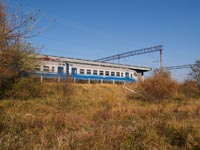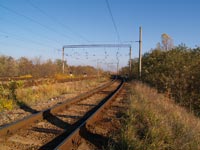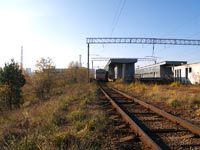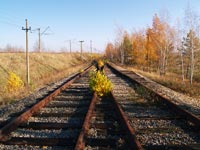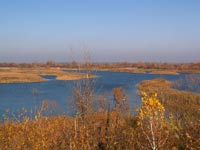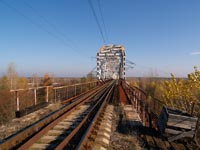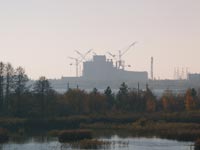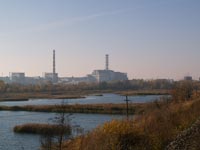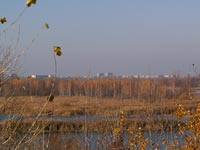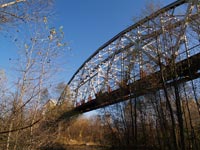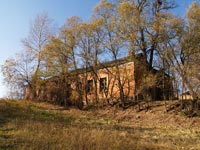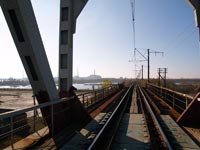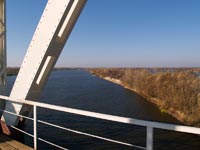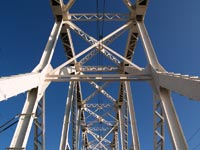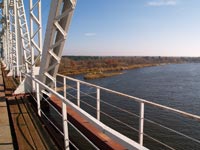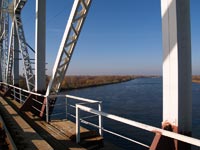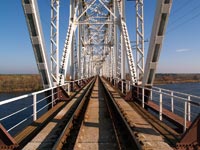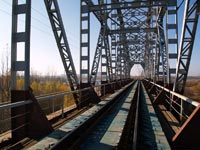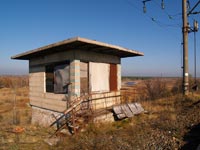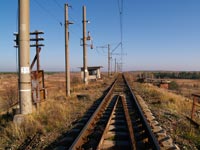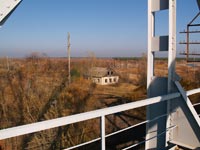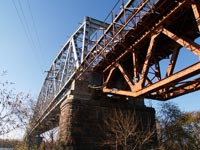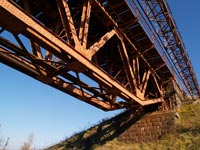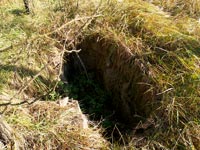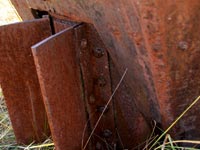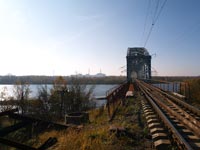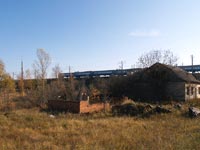The railway bridge, crossing the river Pripyat, was built in the 1930's, together with the branch line which connected Chernigov and Ovruch. This branch line was, as railway-men say, "single-track". The bridge over Pripyat received the name of the nearest large station "
Yaniv", and so began to be called "Yanivsky". However, some sources have since named this bridge "Chornobylsky". The 6-span bridge is about 700 meters long. Before the Second World War, the bridge served a mixture of purposes, both for trains and automobiles. The highway adjoined the bridge, which had rails laid flush to the timbered decking. Cars could thus move to opposite side of the Pripyat.
During WWII, the bridge is typically described as being destroyed by "fascist invaders" in Soviet historiography. However, this bridge was necessary for the advance of units of the Wehrmacht, and its destruction the last thing von Rundstedt’s had on his mind. Actually, the Pripyat bridge (and also the bridge across Dnieper, further by the branch line) was destroyed by soldiers of RKKA (Workers'–Peasants' Red Army) of the fifth army, a brigade led by colonel Moskalenko, on August, 23rd, 1941.

The Germans, having taken control of the territory, decided that to restore both bridges would be ultimately unprofitable, and all trains were subsequently diverted in the Chernigov direction through Kiev. The branch line "Ovruch-Chernigov" then fell into disuse for the following ten years. Only in the late fifties, long after WWII had ended, were railway bridges of this branch through the river Pripyat here and at Dnieper rebuilt, and train service restored.
The Station "Semihody". It received its name from small village about 4 km from station. Before the failure on ChNPP in 1986, it was a common passenger platform. Since then, it became the terminal station of special route "Slavutich- Semihody", and was equipped with a sanitary inspection room. Here electric trains ER9 (rented by a public body "Chornobylservis" from the Chernigov depot of the Southwestern Railways (SWR)) conveyed personnel of ChNPP to their homes in Slavutich.
The Yanivsky bridge, together with the Ovruch-Chernigov branch, then continued a quiet life as a minor "single-track" part of Southwestern Railways, until the failure on ChNPP in 1986. On April 29th, 3 days after the accident, all through traffic was stopped, and the "Ovruch-Chernigov" branch began work anew in "Chornobyl" mode. This involved the evacuation of villages near Pripyat, and supplying technical materials for liquidations works and ChNPP failure mitigation. Due to heavy contamination of the embankment, attempts were made during this time to clean the Yanivsky bridge, the ballast under the tracks on the bridge and the railway sleepers were also replaced. By 1988, work to electrify the branch was finished.
View from the side of the bridge towards station "Semihody". Directly: the first and second stage of ChNPP. At the left: unfinished 5 and 6 units of the third stage. On the right: the city Pripyat.
View on the bridge from the right bank. A barrack of bridge guard. A view on ChNPP from the bridge.
On the bridge.
Track facilities on a part Chernigov- Semihody including bridges through Pripyat and Dnieper, are served by the Chernigov PCh-10, a contact network - the Chernigov ECh-9. In 2005 the bridge has been repaired and painted.
On the left bank of Pripyat.
The rests for a bridge defense line. The entrenchments was strengthened by a stone and a machine-gun tower for "Maxim". It was strange, but I couldn't find any rests for the defensive installations on the East bank. They could have been lost in dense riverside thickets, or, according to the Soviet defensive doctrine, it was assumed an attack could only come from an enemy in the West :)
View on the right bank of Pripyat. Electric train ER9 on the way to Slavutich.
October, 2010. A Chernobyl Zone of Alienation. The railway bridge through the river Pripyat.


